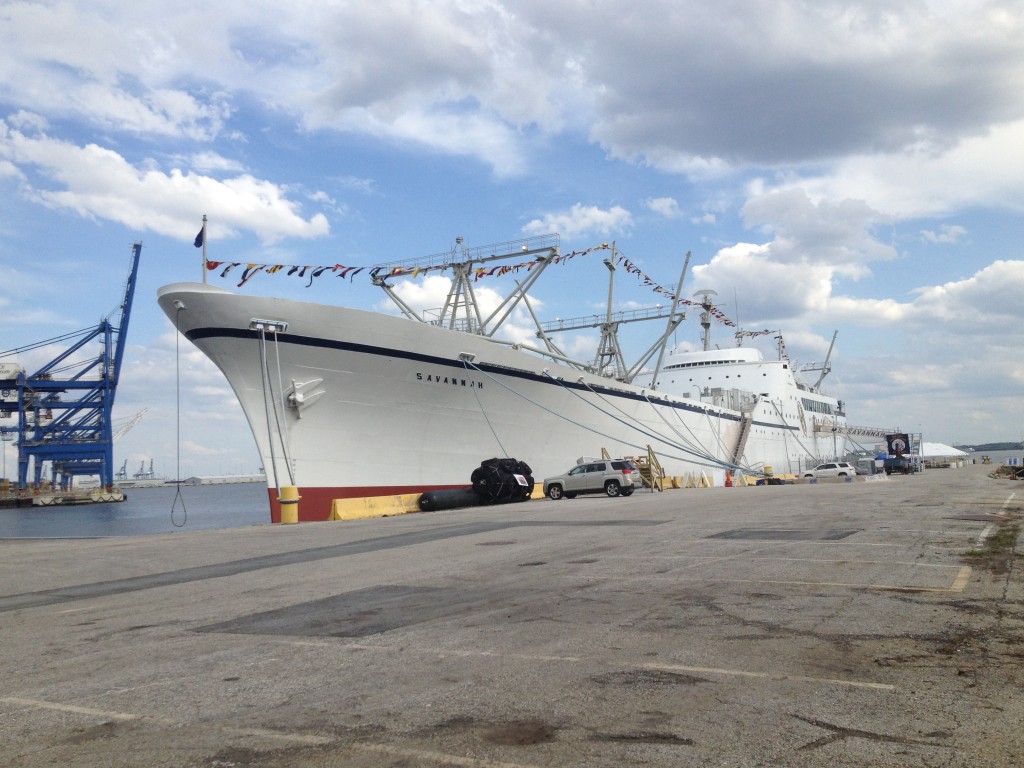ANS Historic Landmark N.S. SAVANNAH Hosts Gala Weekend
The weekend of May 17-18, 2014, saw a beehive of activity on board the beautiful nuclear powered ship N.S. Savannah, docked now in Baltimore. The ship was being prepared on May 18 for open public touring-a rare event indeed for this ship that is still a Nuclear Regulatory Commission licensed facility-in commemoration of National Maritime Day (which actually is May 22.) To this end, the ship was abuzz with workers from the U.S. Maritime Administration (MARAD) and its ever-present Ship's Master, Erhard Koehler, as well as workers from other organizations and, of course, the N.S. Savannah Association (NSSA), which works with MARAD to preserve and restore the ship.
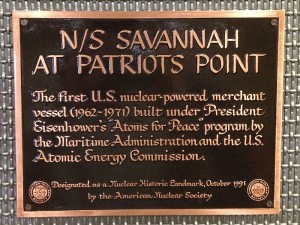 The ship was designated as a Nuclear Historic Landmark by the American Nuclear Society in 1991 while a part of the small fleet at Patriots Point Naval Museum, Charleston, S.C. Since that time, the ship has moved to a number of locations (including for some time the James River Reserve Fleet) before finally ending up at the pier in Baltimore where she now sits, being actively repaired and restored by MARAD and NSSA with an eventual view towards completion of the nuclear decommissioning of the ship in 2031. This process will only remove and dispose of such parts of the power plant as are necessary (for example, the reactor vessel) while keeping the rest of the ship intact.
The ship was designated as a Nuclear Historic Landmark by the American Nuclear Society in 1991 while a part of the small fleet at Patriots Point Naval Museum, Charleston, S.C. Since that time, the ship has moved to a number of locations (including for some time the James River Reserve Fleet) before finally ending up at the pier in Baltimore where she now sits, being actively repaired and restored by MARAD and NSSA with an eventual view towards completion of the nuclear decommissioning of the ship in 2031. This process will only remove and dispose of such parts of the power plant as are necessary (for example, the reactor vessel) while keeping the rest of the ship intact.
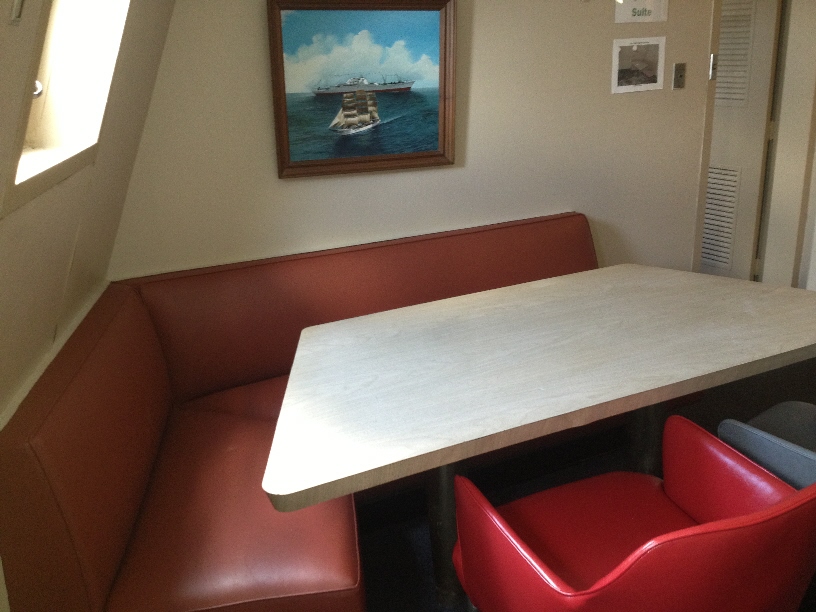
Captain's Stateroom, N.S. Savannah. This stateroom was restored using funds obtained by the N.S. Savannah Association, and had been in serious disrepair for many years.
The condition of the ship improves quite steadily as time goes on. This doesn't just mean paint where it's needed and cleaning often; it means active restoration of the many and varied spaces on the ship, slowly over time-even as preparations continue for the decommissioning work. One notable status change for one of the spaces on the ship came when Erhard Koehler designated passenger stateroom A17 as the new on board office space for the N.S. Savannah Association.
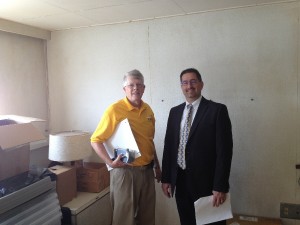 Here, we see NSSA Chairman Jay Tarzia (right) and NSSA President Bob Moody (left) in former passenger stateroom A17 on board the ship. NSSA operates the gift shop on board (located in the original ship's store) and so must store items on board the ship to replenish stock; A17 serves that purpose. In addition, materials donated to NSSA on board the ship are kept here as well as other items owned by the association either for preservation or operation of displays or sales. As can be seen at the edge of the photo, the original lamps are still in place in A17 (as is the original sleeper couch.) A17 was a three-person stateroom.
Here, we see NSSA Chairman Jay Tarzia (right) and NSSA President Bob Moody (left) in former passenger stateroom A17 on board the ship. NSSA operates the gift shop on board (located in the original ship's store) and so must store items on board the ship to replenish stock; A17 serves that purpose. In addition, materials donated to NSSA on board the ship are kept here as well as other items owned by the association either for preservation or operation of displays or sales. As can be seen at the edge of the photo, the original lamps are still in place in A17 (as is the original sleeper couch.) A17 was a three-person stateroom.
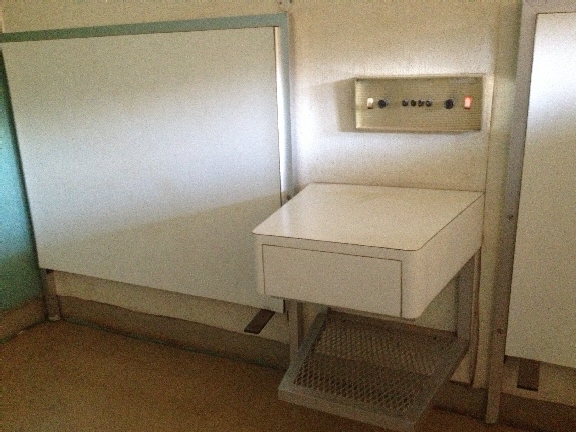
Much original decor remains in stateroom A17. The two headboards of the passenger bunks (now gone) are visible, as is the nightstand between the bunks. The stand features a pull out drawer and underside rack. Above this can be seen a gold control box; this box has buttons to select from the four-track on board music system, a volume control, and a steward call button. Many of these throughout the ship still have power.
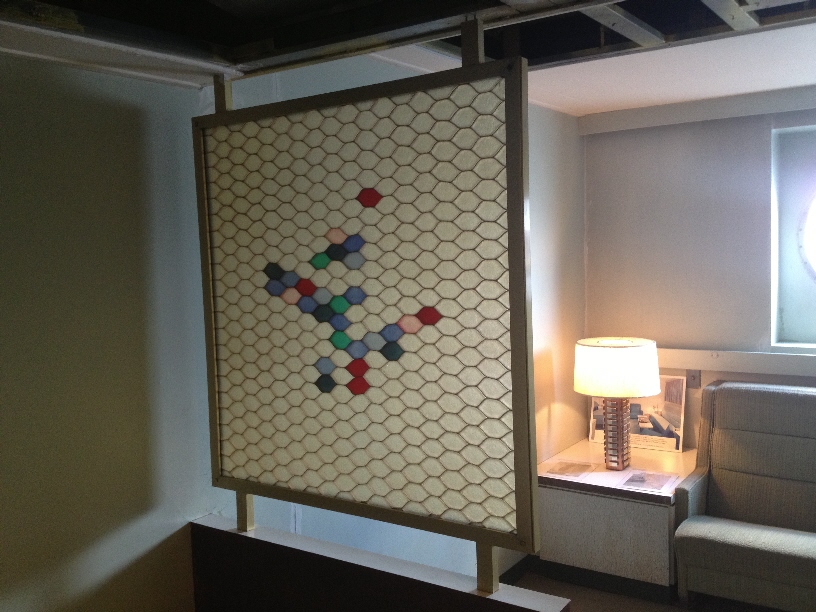
Some staterooms on board the ship have been completely restored and are on the tour route, as seen here. The room dividers are of many different styles.
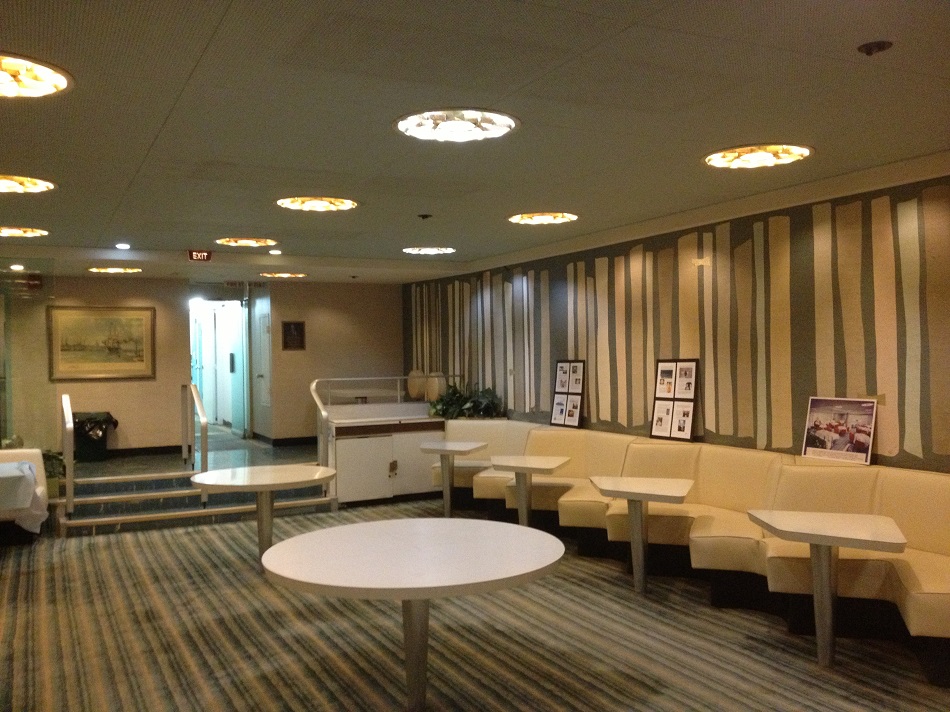
Some spaces on the ship are partially restored, with the rest being original. The main dining room is one such example - the carpet is original. NSSA has found the manufacturer and is in the process of determining if exact replacement can be found or made.
The ship was in a complete state of readiness by the time tours began at 10 AM on Sunday. Visitors received a safety briefing on the pier prior to being allowed access to the ship; while on board, visitors were permitted to tour freely and were assisted by personnel from various organizations, including MARAD and NSSA.
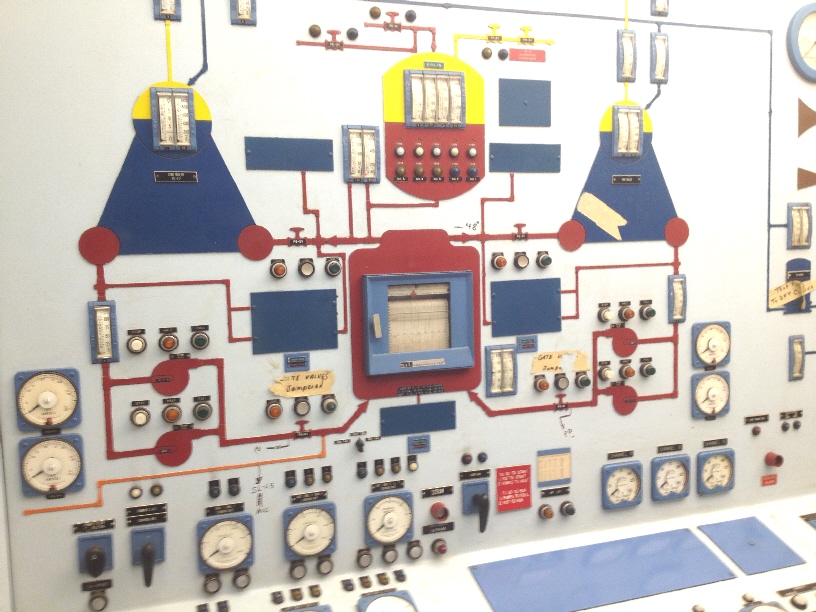
On Sunday, select groups of passengers were taken to the control room by NSSA Event Coordinator Bucky Owens - himself a former reactor operator on the ship. These spaces are not normally toured by the public. This photo (taken May 17) shows the vertical portion of the reactor control section of the console.
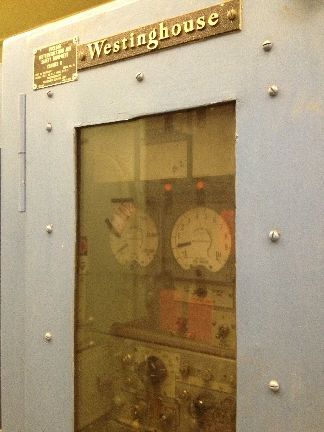 It may be a surprise to those interested to learn that much of the instrumentation and control equipment remains intact; this is located aft of the control room and is in spaces not visible from the viewing gallery around the engine room.
It may be a surprise to those interested to learn that much of the instrumentation and control equipment remains intact; this is located aft of the control room and is in spaces not visible from the viewing gallery around the engine room.
At left, we see a nuclear instrument cabinet manufactured by Westinghouse. Westinghouse provided the nuclear instrumentation for the ship, as well as the reactor protection equipment, under contract to Babcock & Wilcox (which built the nuclear steam supply system.) This equipment uses magnetic amplifiers-a term rapidly losing its significance in a generation that is seeing not only digital microprocessor equipment but flat screen type displays as well.
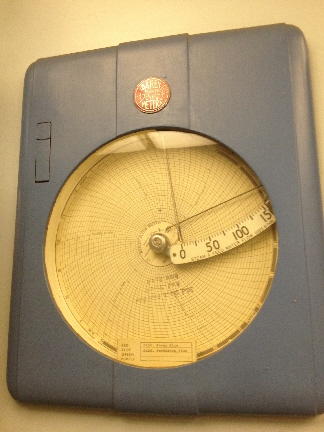 Also found aft of the control room are a large number of Bailey Meter Co. recorders, such as the one seen at left. These can track one, two, or more parameters on a single circular chart using different colored ink markers; this example, which measures starboard steam generator steam flow and feed flow, used red for steam flow and blue for feed flow. The last time the reactor was operated was November 1970, when the ship was moved to Galveston for defueling, and the partially visible date on this chart correlates. Dozens of blanks for these Bailey Meter Co. fluid indicators were found intact in the I&C (instrumentation and control) work shop on the ship.
Also found aft of the control room are a large number of Bailey Meter Co. recorders, such as the one seen at left. These can track one, two, or more parameters on a single circular chart using different colored ink markers; this example, which measures starboard steam generator steam flow and feed flow, used red for steam flow and blue for feed flow. The last time the reactor was operated was November 1970, when the ship was moved to Galveston for defueling, and the partially visible date on this chart correlates. Dozens of blanks for these Bailey Meter Co. fluid indicators were found intact in the I&C (instrumentation and control) work shop on the ship.
A number of ceremonies occurred on Sunday on the ship including the official MARAD National Maritime Day Observance Ceremony (in which NSSA's Christie Moody participated) as well as a ceremony in the Eisenhower Room dedicating a plaque to the late NSSA founding member Wayne Britz, in which NSSA's President Bob Moody and board of directors member Bruce Muntz, as well as MARAD's Erhard Koehler, delivered speeches and comments.
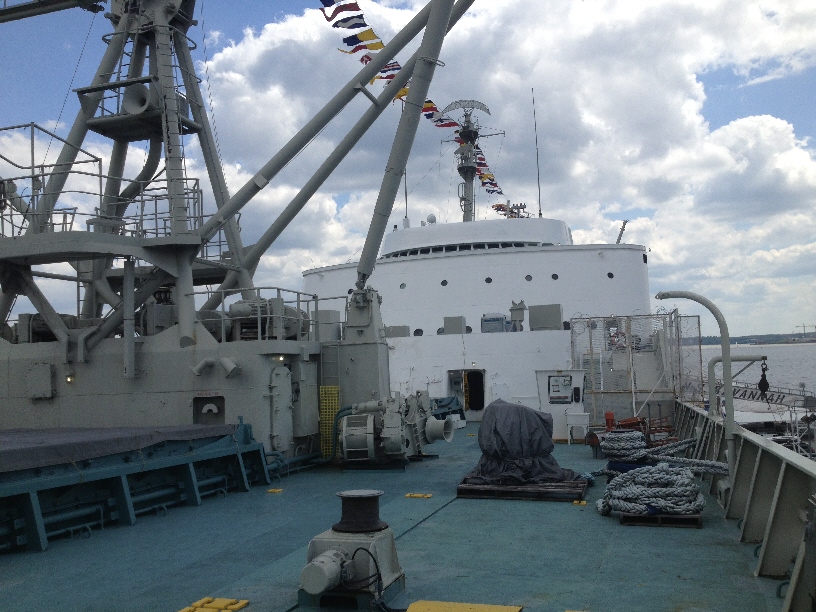
Sunday's open house also featured a large number of pier displays and activities, including remote-controlled boats, a model of the first working steam-propelled boat (with a grasshopper-style steam engine), and many display tents. Hundreds of local citizens, Naval cadets, and officers and sailors toured the ship on Sunday.
The weekend was considered a complete success by all involved, and once again the N.S. Savannah was able to show her distinctive and unique beauty.
For more information:
Footnote....
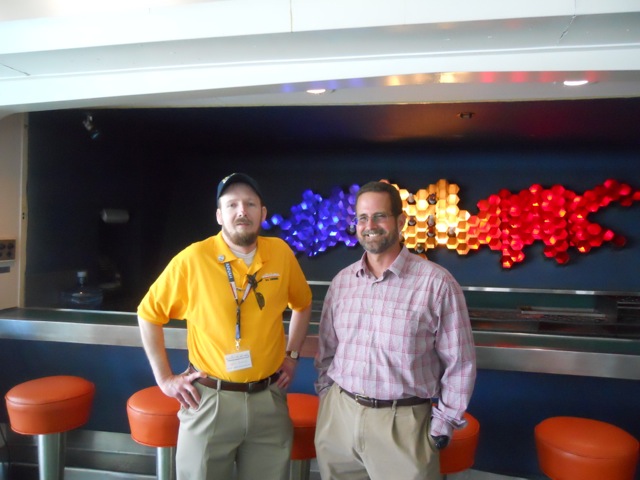
It's pretty unusual to find more than one nuclear blogger in one spot, but on Sunday we nearly reached critical mass. On the left, Will Davis, in uniform as Ship's Docent and NSSA Communications Director; on the right, Rod Adams. This was taken in the Veranda; the colored wine rack behind the bar represents the Trilinear Chart of the Nuclides. Photo courtesy Rod Adams.
____________________________________
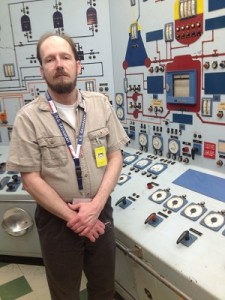 Will Davis is the Communications Director for the N/S Savannah Association, Inc. where he also serves as historian and as a member of the board of directors. He is also a consultant to, and writer for, the American Nuclear Society; an active ANS member, he is serving on the ANS Communications Committee 2013-2016. In addition, he is a contributing author for Fuel Cycle Week, is secretary of the board of directors of PopAtomic Studios, and writes his own popular blog Atomic Power Review. Davis is a former US Navy reactor operator, qualified on S8G and S5W plants.
Will Davis is the Communications Director for the N/S Savannah Association, Inc. where he also serves as historian and as a member of the board of directors. He is also a consultant to, and writer for, the American Nuclear Society; an active ANS member, he is serving on the ANS Communications Committee 2013-2016. In addition, he is a contributing author for Fuel Cycle Week, is secretary of the board of directors of PopAtomic Studios, and writes his own popular blog Atomic Power Review. Davis is a former US Navy reactor operator, qualified on S8G and S5W plants.


